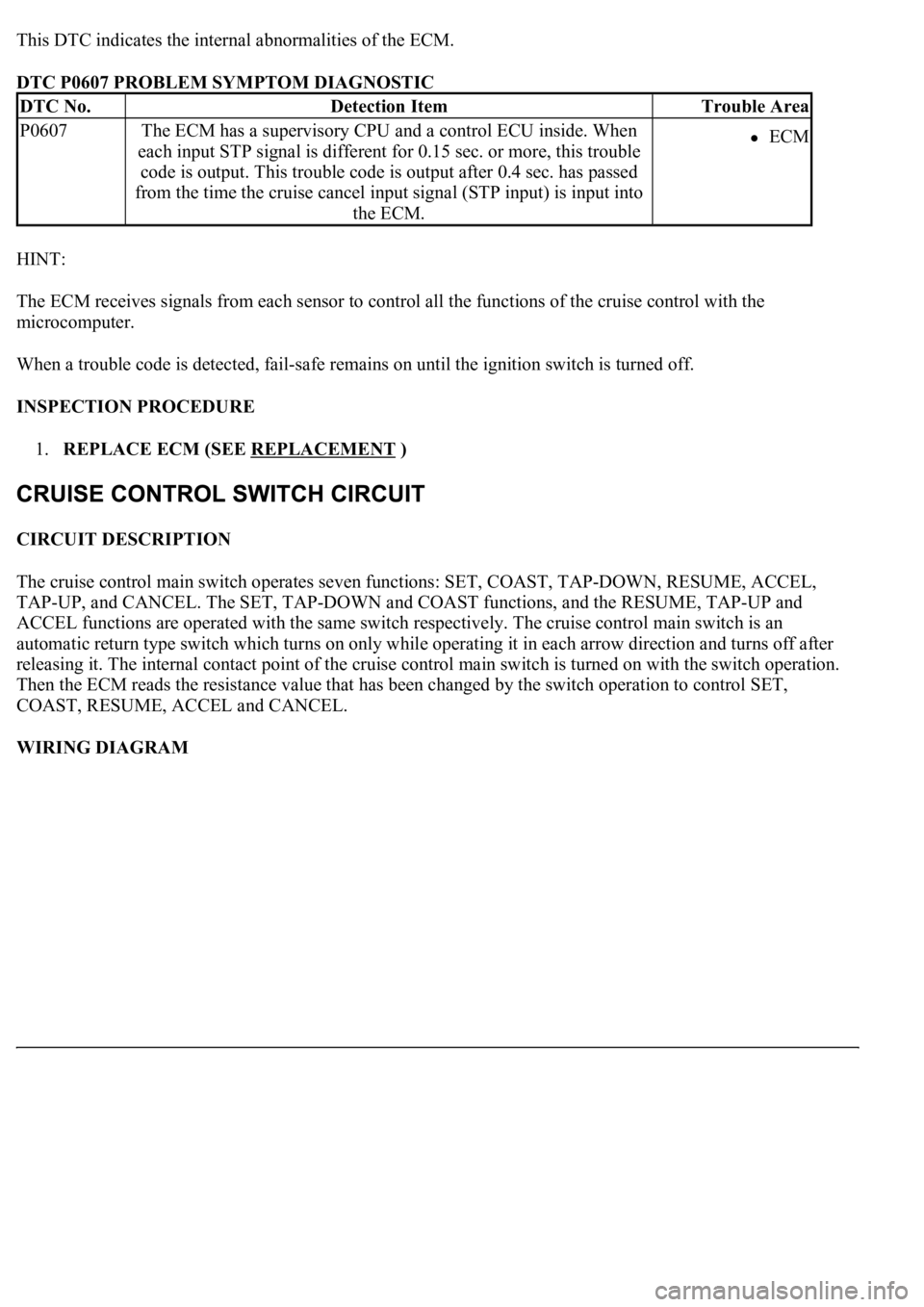Page 1932 of 4500

This DTC indicates the internal abnormalities of the ECM.
DTC P0607 PROBLEM SYMPTOM DIAGNOSTIC
HINT:
The ECM receives signals from each sensor to control all the functions of the cruise control with the
microcomputer.
When a trouble code is detected, fail-safe remains on until the ignition switch is turned off.
INSPECTION PROCEDURE
1.REPLACE ECM (SEE REPLACEMENT
)
CIRCUIT DESCRIPTION
The cruise control main switch operates seven functions: SET, COAST, TAP-DOWN, RESUME, ACCEL,
TAP-UP, and CANCEL. The SET, TAP-DOWN and COAST functions, and the RESUME, TAP-UP and
ACCEL functions are operated with the same switch respectively. The cruise control main switch is an
automatic return type switch which turns on only while operating it in each arrow direction and turns off after
releasing it. The internal contact point of the cruise control main switch is turned on with the switch operation.
Then the ECM reads the resistance value that has been changed by the switch operation to control SET,
COAST, RESUME, ACCEL and CANCEL.
WIRING DIAGRAM
DTC No.Detection ItemTrouble Area
P0607The ECM has a supervisory CPU and a control ECU inside. When
each input STP signal is different for 0.15 sec. or more, this trouble
code is output. This trouble code is output after 0.4 sec. has passed
from the time the cruise cancel input signal (STP input) is input into
the ECM.ECM
Page 1933 of 4500
Fig. 26: Wiring Diagram - Cruise Control Switch Circuit
Courtesy of TOYOTA MOTOR SALES, U.S.A., INC.
INSPECTION PROCEDURE
1.READ VALUE ON HAND-HELD TESTER
a. Connect the hand-held tester to the DLC3.
b. Turn the ignition switch to the ON position.
c. Accordin
g to the display on the tester, read the "DATA LIST".
Page 1941 of 4500
OK: When cruise control main switch operation is performed the standard values will be above.
NG: REPLACE ECM (SEE REPLACEMENT
)
OK: PROCEED TO NEXT CIRCUIT INSPECTION SHOWN ON PROBLEM SYMPTOMS
TABLE
CIRCUIT DESCRIPTION
Making a short circuit between terminals TC and CG of the DLC3 will output DTCs from the DLC3.
WIRING DIAGRAM
Fig. 32: [Wiring Diagram
- Diagnosis Circuit]
Courtesy of TOYOTA MOTOR SALES, U.S.A., INC.
HINT:
When a particular warning light stays blinking, a ground short in the wiring of terminal TC of the DLC3 or an
internal ground short in the relevant ECU is suspected.
INSPECTION PROCEDURE
CCS
INDICATORSCruise indicator signal (Sub
CPU) /ON or OFFON: "CCS READY" ON OFF:
"CCS READY" OFF-
Page 1991 of 4500
Fig. 2: Defogger System Diagram
Courtesy of TOYOTA MOTOR SALES, U.S.A., INC.
Communication Table
COMMUNICATION TABLE
1.GENERAL
The rear window defogger system's thin heater wires are attached to the inside of the rear window and
defog the window surface quickly. The indicator lamp illuminates while the system is operating. The
system automatically turns off after approximately 15 minutes.
2.FUNCTION OF MAIN COMPONENT
SenderReceiverSignalLine
Multi-display(1)A/C control assemblyRear defogger switch
signalBEAN
Center cluster integration
panel
(2)
A/C control assemblyRear defogger switch
signalBEAN/AVC-LAN
(1)w/ LEXUS navigation system
(2)w/o LEXUS navigation system
Page 1998 of 4500
c. Perform the ACTIVE TEST by following the directions on the tester screen.
A/C control assy:
A/C CONTROL ASSY - REFERENCE TABLE
CIRCUIT DESCRIPTION
When the defogger switch is turned on, a rear defogger activation request signal is input to the A/C control (A/C
ECU) from the multi-display
1 or center cluster integration panel2 . Then, the A/C control assembly outputs this
signal to the defogger relay (Marking: DEFOG) and the rear window defogger system is activated.
HINT:
1. w/ LEXUS navigation system
2. w/o LEXUS navigation system
WIRING DIAGRAM
ItemTest DetailsDiagnostic Note
DEFOGGER RLY-ROperate rear window defogger OFF/ON-
Page 1999 of 4500
Fig. 8: Rear Window Defogger System - Wiring Diagram
Courtesy of TOYOTA MOTOR SALES, U.S.A., INC.
INSPECTION PROCEDURE
1.INSPECT FUSE
a. Select the ACTIVE TEST, use the han
d-held tester to generate a control command, and then check
Page 2180 of 4500
Fig. 2: System Diagram
Courtesy of TOYOTA MOTOR SALES, U.S.A., INC.
COMMUNICATION CHART
SenderReceiverSignalCommunication Line
SenderReceiverSignalCommunication Line
Driver Door ECUTheft Warning ECUDriver door closer operating signalBEAN
Passenger Door
ECUTheft Warning ECUPassenger door closer operating
signalBEAN
Rear Door ECU LHTheft Warning ECURear left door closer operating
signalBEAN
Rear Door ECU Theft Warning ECURear right door closer operating BEAN
Page 2183 of 4500
Fig. 5: Door ECU Operation Diagram
Courtesy of TOYOTA MOTOR SALES, U.S.A., INC.
c. Cancel Function
In the door closer system, operating the inside or outside door handle cuts the link between
the latch and the closer motor. This cancels the system and allows the door to be opened
regardless of the state of the system.
For example, if the system is operating from the half latched state to the fully latched state,
the actuation force of the motor causes the latch lever to push and turn the latch so that the
striker can be pulled in by the latch.
While the closer system is activated, operating the inside or outside door handle disengages
the latch lever and latch. This releases the latch, allowing the door to open.